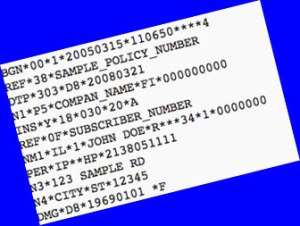What Is An 834 Transaction, And Why Should I Care?

Sample 834 data. It’s not supposed to be diagonal, don’t worry.
That’s what an “834” is: the type of secure electronic transaction that the federal site sends over to insurers. It identifies a customer, sends over personal information, and tells the company what plan to enroll them in. Simple enough. Insurance companies are already receiving calls from people who think they’re enrolled, but their purported insurer has no record of them.
If consumers and insurance companies are already having 834 problems, imagine what it will be like when all of these policies are supposed to go into effect in January. How many people will think they’re insured when they aren’t, due to 834 errors?
Well, we don’t know. That’s because the Centers for Medicare and Medicaid Services, which runs Healthcare.gov, refuses to give the error rate to reporters. Individual stories of errors are filtering through to the press, though: incorrect enrollments, dependents coded as additional spouses, and people enrolling and leaving the same plan multiple times in each day.
Right now, insurance companies are able to hand-check forms as they come through, but as enrollments pick up later this year that may not be feasible. What then? The Centers for Medicare and Medicaid Services says that its site will stop sending over garbled information every night by then. We’ll find out when it happens: just make sure to follow up and make sure that any plan that you enroll in has your correct information before it goes into effect. That’s the case for any other health insurer, even the one that your own employer enrolls you in, though.
HealthCare.gov’s Mysterious New Number: ‘834’ [ProPublica]
Want more consumer news? Visit our parent organization, Consumer Reports, for the latest on scams, recalls, and other consumer issues.

